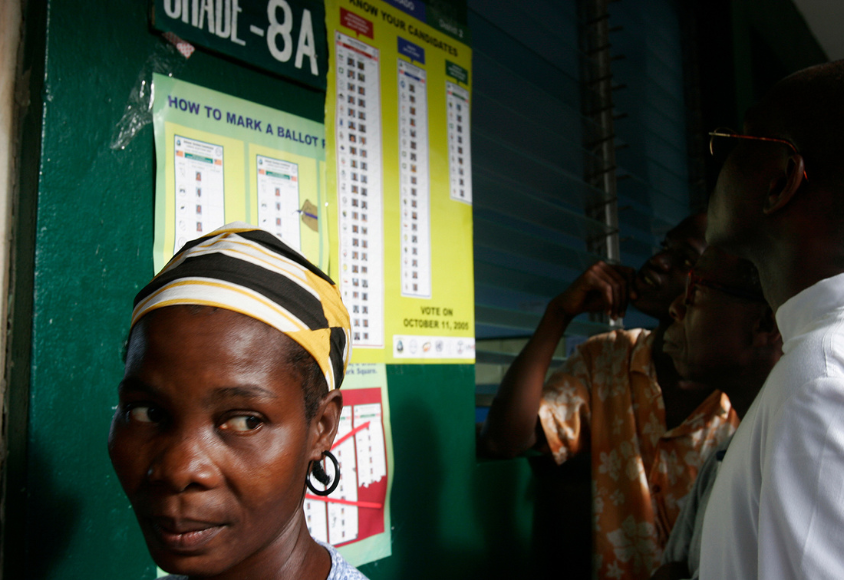Civil society: Taking to the streets for more inclusive peace
The Nobel Peace Prize for 2022 was awarded to three laureates who, in the words of the Norwegian Nobel Committee, “demonstrate the significance of civil society for peace”: the Belarusian human rights advocate Ales Bialiatski, the Russian human rights organisation Memorial and the Ukrainian Center for Civil Liberties. With its decision, the Nobel Committee recognizes that civil society actors and human rights activists are particularly under threat in autocracies and in times of war – but that they also play a pivotal role in documenting war crimes, holding authorities accountable and standing up for peace and democracy.
To show how exactly this is done, Julia Strasheim looks at three examples of peace processes from recent history. Taken together, these examples demonstrate how civil society in the past has raised its voice to make peace more sustainable, democratic and just. We therefore decided to publish her article “Civil Society: Taking to the streets for more inclusive peace” early. It is her contribution to our BKHS Magazine, which will be published virtually and in print on 10 November 2022 on the occasion of the 2022 Helmut Schmidt Lecture.
Listen to the essay here:
From Afghanistan to Ukraine, the brunt of war is being borne by ordinary civilians. But efforts to end wars are often dominated by representatives of the warring parties, while civil society remains excluded from peace talks. Three examples show how civilians are still raising their voices to demand a greater say in the peace process.
War and armed conflict have long been among the greatest threats to human security worldwide. Since 1989, numbers from the Uppsala Conflict Data Program show that 190 conflicts took place in almost 100 countries, with nearly a million civilians being killed in deliberate attacks by armed actors. This number, however, does not even begin to account for the millions more who have been injured, tortured or abused during war, who have died from starvation or diseases as a result of war, or who have been forcibly displaced.
Countries such as Afghanistan, as the UN High Commissioner for Human Rights, Michelle Bachelet, recently argued, are “among the deadliest places in the world to be a civilian” (OHCHR 2021). In Ukraine, human rights NGOs have documented horrific violence against civilians by Russian troops since February 2022, including executions, torture and sexualised violence; we have seen bombing of residential areas, schools and hospitals, as well as the use of particularly brutal weapons, such as cluster munitions and landmines. For its pioneering role in identifying and documenting Russian war crimes against Ukrainian civilians, the human rights organization Center for Civil Liberties was awarded the Nobel Peace Prize for 2022.
While the brunt of war is borne by ordinary civilians, the efforts to end war and build peace tend to be dominated by members of the warring parties. Representatives from NGOs, victims’ organisations, women’s groups and political parties tend to be excluded from peace talks. The same applies to religious, spiritual and community leaders. Warring parties often oppose their inclusion and mediators sometimes assume that in order to end a war, armies need to be bought off with a seat at the table, while involving too many actors makes compromise difficult to reach.
As a result, of the 83 peace agreements signed between 1989 and 2004, only a third included at least one civil society actor (Nilsson 2012). In particular, women remain underrepresented. As numbers collected by the Council on Foreign Relations show, they constituted only 6 percent of mediators or signatories and 13 percent of negotiators in peace talks from 1992 to 2019. The most recent example are the talks between Russian and Ukrainian delegations in early 2022 that took place without a single woman at the table.
Inclusion is essential, not a luxury add-on
But including civilians in peace processes is not a luxury add-on: their participation in decision-making makes negotiations more successful and peace processes more sustainable. Studies show that the risk of a peace agreement breaking down decreases by 64 percent if civil society is involved in talks (Nilsson 2012). The participation of civilians in peace talks can bring forward new ideas for ending a war, increase pressure on the warring parties to implement a deal or undermine the moral authority of those who want to remobilise for war. Civilian participation can also strengthen transparency and the legitimacy of peace processes.
Three examples from recent history thus show how civilians can raise their voices and speak up to demand a greater say in the peace process – against all odds.
“Sisterhood, Prayer, and Sex”
One of the most famous examples of ordinary people speaking up for peace was Liberia’s Women in Peacebuilding Network Mass Action for Peace campaign, which forced the warring parties to engage in peace talks in 2003. One of the campaign’s leaders was Leymah Gbowee, who received the 2011 Nobel Peace Prize for her nonviolent struggle for women’s participation and who tells her story in the book How Sisterhood, Prayer and Sex Changed a Nation at War (Gbowee 2013). The movement was made up of Christian and Muslim women from all parts of Liberian society who used a number of nonviolent tactics to mobilise for peace, including organising marches, going on a sex strike, congregating for prayers and meeting with the warring parties. On one occasion, women physically prevented warring party representatives from leaving the peace talks by threatening to take off their clothes and barricading the entrance to the meeting room. The campaign was so successful as it gave a human face to the war and because tactics such as the sex strike gained widespread international media attention. The peace deal was subsequently not only signed by the warring parties, but also by 18 political parties and many NGOs. By participating in the talks, the groups were able to ensure that clauses relating to war crimes and human rights violations were part of the agreement.
Only a few years later, but on the other side of the world, it is safe to say that there would not even have been a peace accord to end the war in Nepal had it not been for ordinary citizens taking a stand for peace and democracy. In April 2006, reacting to a coup d'état by the King of Nepal against the democratically elected government, ordinary Nepalis – led by respected civil society and human rights leaders – took to the streets in thousands. Their 19-day-long, country-wide protest would become known as the Jana Andolan II or People’s Movement. The palace reacted by announcing curfews and sending security forces to violently crack down on demonstrations, but this only brought more people out on to the streets. This increasing pressure on the palace was successful in ending direct rule by the king and in creating an environment conducive for peace negotiations. In Nepal’s November 2006 peace accord and subsequent deals, the warring parties agreed to include civil society, women and indigenous groups in decision-making and allocated them 48 seats in the transitional parliament.
Against all odds
In Cambodia in 1991, the odds were certainly not in favour of civilians speaking up for peace. The country’s history of war, genocide and autocracy meant that independent community organisations and political parties had never even existed and the only Cambodians consistently participating in peace negotiations were those with guns. The warring parties opposed proposals to include the wider population in peacemaking and perceived this as a threat to their hold on power. In its article Make Room for Cambodians, the New York Times concluded in 1991: “Inclusiveness, the world was told only two months ago, was the key to peace in Cambodia”, but clearly that did not mean including the Cambodian public.
But Cambodians did demand a greater say in the peace process. Traditional Buddhist organisations were re-established and new NGOs were founded immediately after the peace accord was signed in October 1991. They would come to play a crucial role in safeguarding human rights and creating awareness of environmental threats. Protests took place in the capital – impossible only months earlier. In May 1992, a Buddhist peace march that had begun in a refugee camp on the Thai-Cambodian border arrived in Phnom Penh to strengthen popular confidence in the peace process. And contrary to the expectations of many observers, 4.2 million Cambodians – a turnout of nearly 90 percent – went to the polls in the country’s first national elections in 1993, despite threats of violence and in a powerful demonstration of what speaking up for peace means.
This spirit was also reflected in the 2022 decision by the Norwegian Nobel Committee. Awarding the Nobel Peace Prize to human rights advocate Ales Bialiatski from Belarus, the Russian human rights organisation Memorial and the Center for Civil Liberties demonstrates the significance of civil society for peace – in their home countries and beyond.
Julia Strasheim (@juliastrasheim) is Deputy Managing Director and Programme Director European and International Politics at the Bundeskanzler-Helmut-Schmidt-Stiftung (BKHS).
Bibliography
Gbowee, L. (2013): Mighty be our powers: how sisterhood, prayer, and sex changed a nation at war, New York: Beast Books.
Nilsson, D. (2012): Anchoring the peace: civil society actors in peace accords and durable peace, International Interactions 28(2), 243-266.
Office of the United Nations High Commissioner for Human Rights (2021): Civilian casualties surged after peace talks began in Afghanistan, https://www.ohchr.org/en/2021/02/civilian-casualties-surged-after-peace-talks-began-afghanistan-un-report.
The New York Times (1991): Opinion: make room for Cambodians, https://www.nytimes.com/1991/12/25/opinion/make-room-for-the-cambodians.html.



